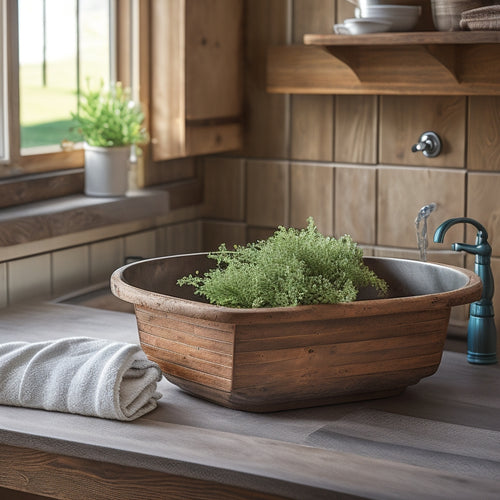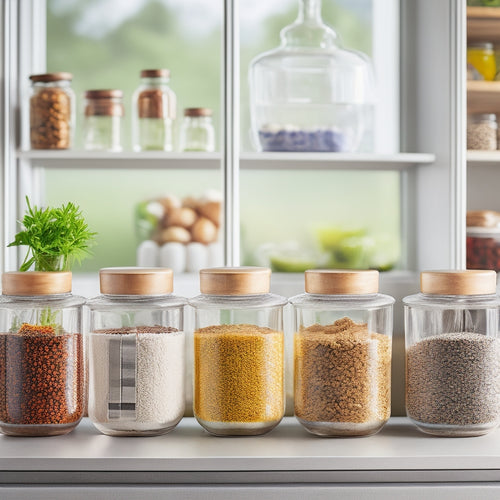
3 Essential Hacks for Tiny Kitchen Cabinets
Share
You can turn even the smallest kitchen cabinets into functional and efficient storage spaces by implementing a few clever hacks. First, maximize vertical space by attaching a spice rack to the inside of a cabinet door or installing a pegboard for hanging utensils. Next, optimize your cabinet layout by arranging contents strategically and using vertical organizers for quick access to frequently used items. Finally, utilize hidden spaces by installing pull-out shelves or baskets in hard-to-reach areas. By putting these essential hacks into practice, you'll be well on your way to creating a kitchen that's both stylish and functional - and there are even more innovative solutions waiting to be discovered.
Key Takeaways
• Incorporate double-duty storage solutions, like spice racks on cabinet doors or pegboards on backs, to maximize space and organization.
• Optimize cabinet layout with vertical organizers, adjustable shelves, and lazy susans to ensure easy access to frequently used items.
• Utilize hidden spaces, such as the back of doors or inside cabinet walls, for storage with pull-out shelves, baskets, or adhesive hooks.
• Make the most of limited cabinet space with slide-out trash cans, pull-down drying racks, or over-the-door organizers.
• Customize storage with drawer dividers and vertical organization techniques to keep utensils and kitchen tools organized and within reach.
Double-Duty Storage Solutions
Maximize your tiny kitchen cabinets' storage capacity by incorporating double-duty solutions that serve multiple purposes, like a spice rack attached to the inside of a cabinet door. This clever door storage hack frees up shelf space while keeping your spices within easy reach.
You can also install a pegboard on the back of a cabinet door to hang frequently used utensils, like pots, pans, and colanders. This vertical organization technique makes the most of your cabinet's often-wasted backside.
Consider adding a slide-out trash can or a pull-down drying rack to your cabinets as well. These double-duty solutions will help you make the most of your limited cabinet space.
Optimize Cabinet Layout Strategies
With only so much real estate to work with, you'll want to strategically arrange your cabinet's contents to make sure that your most frequently used items are easily accessible and that every inch counts.
To maximize your cabinet's potential, consider installing vertical organizers to keep snacks, spices, or cooking supplies within easy reach. You can also use drawer dividers to separate utensils, kitchen tools, or dinnerware, making it simpler to find what you need in a flash.
Adjustable shelves are another game-changer, allowing you to customize your cabinet's layout to fit your unique needs. Place heavy items, like pots and pans, on lower shelves and lighter items, like glassware, on upper shelves.
Don't forget about lazy susans, which can be installed in corner cabinets or on shelves to make the most of hard-to-reach spaces. By optimizing your cabinet layout, you'll be able to cook, prep, and serve with ease, even in the tiniest of kitchens.
With a little creativity and planning, you can turn your compact kitchen into a culinary haven.
Utilize Hidden Spaces Efficiently
Take advantage of the often-overlooked areas in your tiny kitchen cabinets, such as the back of a door or the inside of a cabinet wall, to stash infrequently used items like special occasion dishes or cooking gadgets. This will help declutter your main storage spaces and keep them organized.
Consider installing pull-out shelves or baskets to maximize the use of these hidden areas. This will make it easy to access items without having to dig through entire cabinets.
Another effective way to utilize hidden spaces is by using over-the-door organizers. These can be used to hang items like spice racks, utensils, or even aprons, keeping them within easy reach while keeping your countertops clear.
You can also use adhesive hooks or magnets to hang items like pots, pans, or cooking utensils on the back of a door or inside a cabinet. By utilizing these hidden spaces, you'll be able to free up more room in your tiny kitchen cabinets for the items you use daily, making meal prep and cooking a breeze.
Frequently Asked Questions
How Do I Protect Cabinets From Moisture and Humidity Damage?
Did you know 75% of homeowners experience moisture damage? You can prevent this by using a dehumidifier, placing silica packets in cabinets, and installing cabinet liners. Additionally, apply varnish sealing to protect your cabinets from humidity damage.
Can I Install Cabinets Myself or Should I Hire a Professional?
You can install cabinets yourself, but consider hiring a pro if you're short on time or skills. DIY installation saves you around 20-30% in labor costs, but a professional guarantees a flawless, hassle-free job.
What Is the Ideal Cabinet Height for My Kitchen?
"Measure twice, cut once" - wise words to live by! When determining the ideal cabinet height for your kitchen, consider your personal comfort and the "golden zone" of 30-40 inches from countertop to shelf, optimizing cabinet space for ideal organization.
How Often Should I Clean and Maintain My Kitchen Cabinets?
You should clean your kitchen cabinets every 1-2 months, depending on usage, and maintain them by wiping down surfaces, checking hinges, and organizing contents regularly, regardless of the material, to keep them functional and looking their best.
Are Custom or Stock Cabinets Better for Tiny Kitchens?
When choosing between custom and stock cabinets for your tiny kitchen, you'll need to weigh budget considerations and space optimization against aesthetics and functionality, considering what matters most to you and your clients' needs.
Related Posts
-

Sink Caddy Organizers for Farmhouse Style Kitchens
Sink caddy organizers are perfect for elevating your farmhouse-style kitchen while keeping it functional. You'll love...
-

Stackable Kitchen Containers for Dry Goods
Stackable kitchen containers are perfect for organizing dry goods and maximizing your kitchen space. They help reduce...
-

Innovative Pantry Storage Ideas for Homes
Revamp your pantry into an efficient space with innovative storage solutions. Use vertical storage options like ceili...


